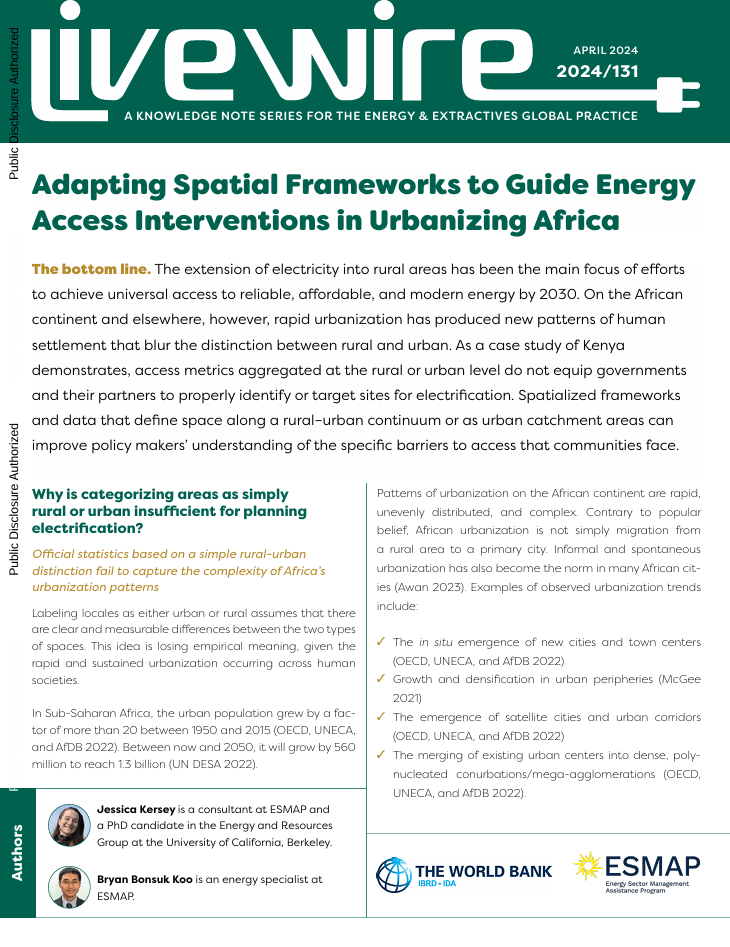Adapting Spatial Frameworks to Guide Energy Access Interventions in Urbanizing Africa
 |
rapport Jun 2024 ; 16 pages
Aut. Jessica Kersey & Bryan Bonsuk Koo
Ed. ESMAP - Washington World Bank - Washington
Téléchargeable sous format: PdF
Téléchargeable chez l'éditeur
Résumé:
L’extension des réseaux d’électricité aux zones rurales a été au centre des efforts visant à assurer un accès universel à une énergie fiable, abordable et moderne d’ici 2030. Sur le continent africain et ailleurs, l’urbanisation rapide a cependant donné lieu à de nouveaux modes d’établissement qui brouillent la distinction entre les zones rurales et urbaines. Comme le montre une étude de cas du Kenya, les indicateurs d’accès agrégés au niveau rural ou urbain ne permettent pas aux gouvernements et à leurs partenaires d’identifier correctement les sites d’électrification. Les cadres et données spatialisés qui définissent l’espace le long d’un continuum rural-urbain ou en tant que zones de captage urbaines peuvent améliorer la compréhension des décideurs quant aux obstacles spécifiques à l’accès auxquels sont confrontées les collectivités.
Dans un contexte d’urbanisation accélérée et de transition démographique, les obstacles à l’accès à l’énergie dépassent la simple distinction entre zones rurales et urbaines. Ce rapport examine dans quelle mesure cette classification binaire entrave les efforts d’électrification en Afrique et plaide pour une adaptation des stratégies d'électrification, une planification plus économique et des juridictions institutionnelles cohérentes. En s’appuyant sur l’exemple du Kenya, les auteurs formulent des recommandations pratiques pour les décideurs politiques, afin d’orienter efficacement les efforts d’électrification dans un environnement en constante évolution. Abstract:
The extension of electricity into rural areas has been the main focus of efforts to achieve universal access to reliable, affordable, and modern energy by 2030. On the African continent and elsewhere, however, rapid urbanization has produced new patterns of human settlement that blur the distinction between rural and urban. As a case study of Kenya demonstrates, access metrics aggregated at the rural or urban level do not equip governments and their partners to properly identify or target sites for electrification. Spatialized frameworks and data that define space along a rural–urban continuum or as urban catchment areas can improve policy makers’ understanding of the specific barriers to access that communities face.
In a period of accelerated urbanization and demographic transition, the barriers to energy access go beyond the simple distinction between rural and urban areas. This report examines the extent to which this binary classification hampers electrification efforts in Africa and advocates for adaptation of electrification strategies, more economic planning and consistent institutional jurisdictions. Drawing on the example of Kenya, the authors provide practical recommendations for policy makers to effectively guide electrification efforts in a changing environment. Contents:
Why is categorizing areas as simply rural or urban insufficient for planning electrification? …………………..1
How does the classification of an area affect efforts to electrify it? ………………………………………………………. 2
Reevaluating Kenya’s Multi-Tier Framework Survey: What insights does a continuum approach offer? ... 3
How can policy makers operationalize the new spatial frameworks? ……………………………………………………. 4
Public-Cible:
Mots clefs: |
accès à l'énergie (CI) (DT) (OP) (ope) , Afrique (CI) (DT) (OP) (ope) , aménagement du territoire (CI) (DT) (OP) (ope) |
Pays concerné: |
Editeurs/Diffuseurs: |
|
ESMAP
-
Energy Sector Management Assistance Program - Washington - Etats Unis |
World Bank - Washington - Etats Unis |
En cas de lien brisé, nous le mentionner à communication@pseau.org